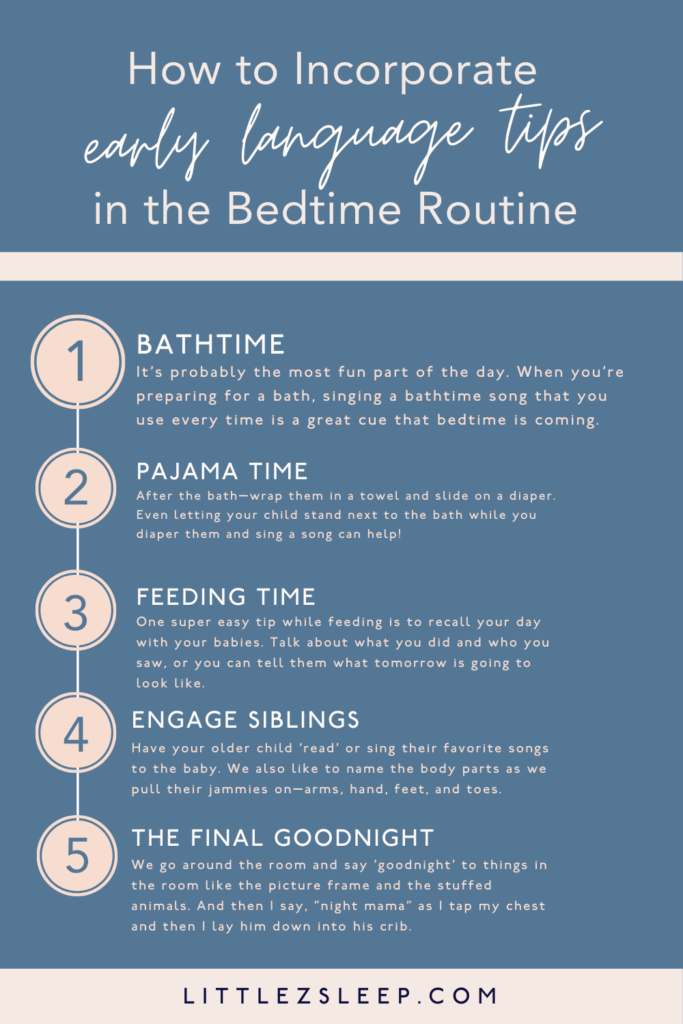If you’ve hung around Little Z’s at any length of time, you probably know that my whole philosophy of sleep revolves around the bedtime routine.
If you are asking me, “why is my child waking up in the morning?” Or, “Why are they suddenly waking up at 2:00 AM? Or why is their nap so short?”
I’m always going to ask you to tell me about their bedtime routines. In this podcast and blog, I’m inviting Carly and Katie of Wee Talkers to share their tips about talking to your child through a bedtime routine. The bedtime routine is the key to understanding your child’s entire journey of sleep.
The Bedtime Routine is the Key to Good Sleep
I have been a pediatric sleep consultant for years, and I have met many families who feel frustrated by bedtime. They don’t find it fun, engaging, and have a hard time connecting to their child. The tips and strategies in this post might help!
But first, let’s hear from our guests, Katie and Carly:
From Katie:
“I’m excited to be joining you guys today. I am Katie and I live in Arizona with my husband and four kids. I have two kids and I am a pediatric speech therapist.”
From Carly:
“I live in Vancouver, British Columbia, and I have two little girls. Katie and I actually met on Instagram and have been working together for two years now. We started an online community for parents and have released a new baby course.”
From Becca:
“I like to say that the bedtime routine is the foundation of all sleep. When we work with families in our online communities, we always ask about the bedtime routine. And once we get that down, in this episode, I’d like to discuss ways we can incorporate language through speaking and singing with our child so that the bedtime routine feels fun while connecting.
At what age, can we start incorporating language into the bedtime routine?”
From Katie and Carly:
“A lot of these strategies span across the ages of babies because their brain is growing faster in the first three years of life. Self-talk is SO important no matter what age they are.
We also know that research tells us that in the first year of life, the quantity of words that your baby hears is going to be the most significant. So it doesn’t matter what you’re saying, as long as it’s authentic. It’s a really important time in development. And there are lots of mini-milestones and steps before your child will get to saying their first words around 12 months. So by incorporating communication into your bedtime routine, you’re just giving them that boost and that strong foundation that they’ll need to be strong communicators down the road.”
From Becca:
“So let’s step into some strategies we can look at tonight as we get into our bedtime routine with our kids.”

The Bedtime Routine:
The Bath
From Katie and Carly:
“Step one in a bedtime routine is a bath. It’s probably the most fun part of the day. When you’re preparing for a bath, singing a bathtime song that you use every time is a great cue! By the time my child was 4 months old, he for sure knew bathtime was coming with that song; it was a predictable pattern.
Once in the bath, we are talking about washing! Washing your tummy, 1..2..3… and pour water over your head. Narrate your bathtime activities to your child! Some kids want to be in and out, but some children enjoy it! It’s a great time to use language through repetition to expose your child to more words.
After bathtime, wrap them in a cozy towel near a mirror. Play peekaboo by putting them in and out of the mirror’s view. Repeat these processes after each bathtime so that your child can recognize the pattern. The whole point of a bedtime routine is to cue your child. It’s also a more gentle approach because your child knows what to expect and gives them a sense of control.
Diapers and Pajamas
So moving on from bath—wrap them in a towel and slide on a diaper. Sometimes older babies are resistant to diapers so incorporating more talking so that your child knows what is coming is important. Even letting your child stand next to the bath while you diaper them and sing a song can help! 1,2,3 under your bum is a fun one!”
From Becca:
“I hear from a lot of moms who say they feel awkward doing this. How would you help them move forward?”
From Katie and Carly:
“One tip we have for you is to think about your baby’s five senses.
What are they hearing? What are they seeing? What are they experiencing? What are they touching? And that will give you a lot of ideas for things that you can say to them. So if that’s you and it feels awkward, you’re definitely not alone. We hear this all the time.
The thing to remember is that your child is not going to judge you— even if you aren’t a musical person. We just encourage you to try”
Feeding: Bottle or Breast Feeding
From Becca:
“Let’s move on to the feeding time! Here at Little Z’s, we really recommend feeding your child and keeping them awake during that time. We don’t want them to associate food to fall asleep. So, we always tell parents to poke, tickle, and talk to them. They feel awkward just staring at their baby—what should they do?”
From Katie and Carly:
“It can feel a bit intimidating, but one super easy tip is to recall your day with your babies. Talk about what you did and who you saw, or you can tell them what tomorrow is going to look like.
Is there anything that is going to happen soon that is easy and natural to talk about, especially with relationships like grandma and grandpa? Remember to incorporate sweet lullabies and songs too.”
From Becca:
“Let’s address engaging with older siblings in the room while you are preparing for bedtime. Often, they can be found running and screaming around the room.”
Engaging with Siblings during the Bedtime Routine
From Katie and Carly:
“We know that this can be tricky! One idea for bathtime is to allow your child to line up toys on the edge of the bathtub and let them plop the toys in. The older sibling can feel in charge as they ‘teach’ the baby some new tricks. Or, have your child help layout the towel, diaper, and jammies after bathtime. Lastly, have your child ‘read’ or sing their favorite songs to the baby. We also like to name the body parts as we pull their jammies on—arms, hands, feet, and toes.
We also take the time to put lotion on our kids with sound effects that a child can find fun, repeat, and engage with. When older babies are getting closer to saying words, they are likely to imitate and copy the words and sounds.”
What if I feel awkward as a parent?
From Becca:
“Let’s address the elephant in the room for some— do we have to become entertainers now to our children? What encouragement do you have for moms who are worried that they can’t sing well?”
From Katie and Carly:
“Start with a strategy that you feel comfortable with! Maybe naming your child’s arm as you slip it into the sleeve of the pajama. And as it gets easier, get more daring and sing a song narrating the bedtime routine.
An easy strategy is what we call serve and return. It’s the basic idea of thinking of communication with your child as a tennis match. For example, if they kick their leg and look towards you with a coo. It’s your chance to return the ‘ball’ with communication. Like, “Oh, I see you are happy you are kicking your legs!” This process of serve and return can feel natural and authentic with your child.
There are going to be nights where it feels like everything goes wrong and that’s ok. The goal is that most nights you are enjoying bedtime and bonding with your child through communication and language.”
How to say goodnight
From Becca:
“What are some ways we can incorporate strategies into that final moment of saying good night?”
From Katie and Carly:
“One of the first things we try is letting them turn off the light (with my help). Then we go around the room and say ‘goodnight’ to things in the room like the picture frame and the stuffed animals. And then I say, “night mama” as I tap my chest and then I lay him down into his crib. Bedtime ends on a really predictable and positive note!
>>Is your child crying when you put them down to sleep because they are dependent on sleep props? Check out this post!
Where can we get more information from Wee Talkers? We offer songs, video training, baby activities, and a course! You can check them out here. ”
From Becca:
“Be sure to follow Wee Talkers on Instagram and at their website at www.weetalkers.com. They have so much to share. They’re so generous with their information and THANK YOU for joining us today.”
And as you head into the bedtime routine tonight, try out some of these strategies, let us know how it goes.
Sweet dreams. See you next time.
Becca
LOVE THIS? PIN IT FOR LATER!

FLASH SALE
ONE WEEK ONLY
Keep sleep a thing on vacation with the Little Z's Travel Guide!